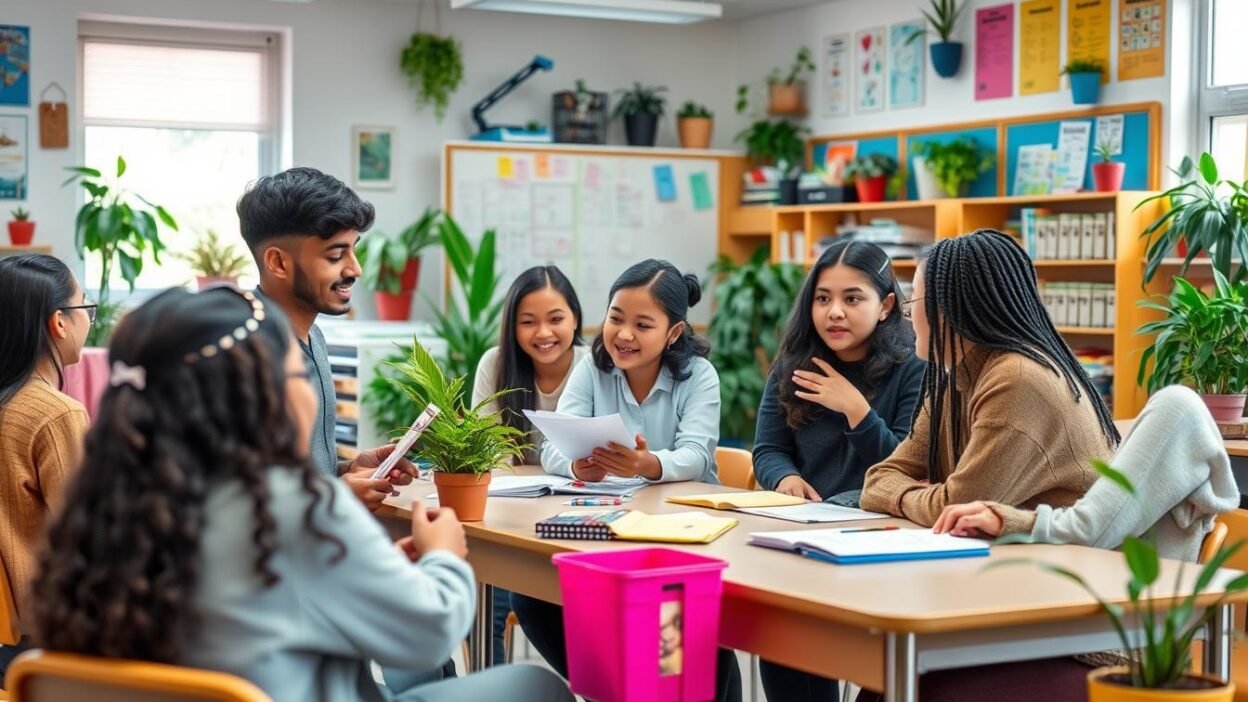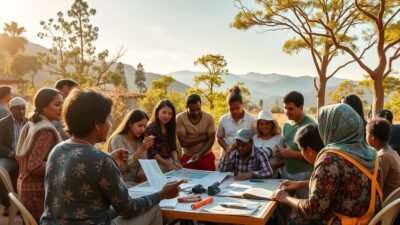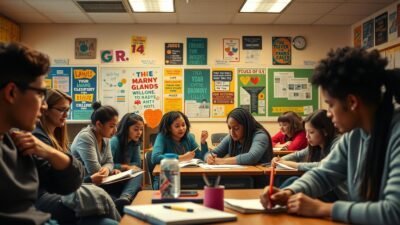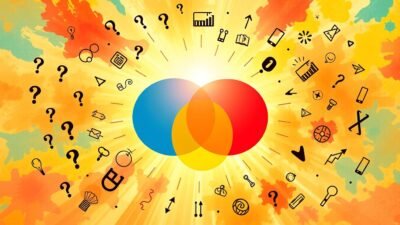Can peer evaluations and self-assessments really replace traditional exams? Educational practices are changing, moving from old tests to new, team-based methods. Old tests mainly test memory, but today’s classrooms focus on critical thinking and teamwork.
This article looks into how peer assessment and self-reflection are changing how we evaluate students. They offer tools that match today’s learning goals.
Today, teaching is more than just grading. Teachers need to create spaces where students can check their own progress and work with others. By using these methods, teachers can fill in the gaps left by old tests. This helps students learn more deeply, not just remember facts.
So, how do these new ways of teaching help students and teachers? The answer is in how they are used and their benefits.
Preparing for the UGC NET exam can be a daunting task, but with the right resources, candidates can navigate the process effectively. Websites like MyJRF provide a comprehensive platform for aspiring educators, offering specialized guidance for UGC NET Paper 2 preparation and essential tips for acing UGC NET Paper 1. Additionally, understanding the revised syllabus provided by UGC is crucial for a targeted study approach. For official announcements and updates, candidates should regularly visit the UGC NET NTA portal, while the UGC’s job section and the main UGC website are invaluable for post-exam opportunities and academic resources. With these tools, candidates can maximize their preparation and set themselves up for success. Preparing for Paper 1 and UGC NET Paper 2 Education requires a strategic approach with quality resources. UGC NET Education aspirants can access structured video lectures that cover essential concepts comprehensively. For an in-depth understanding, check out teaching aptitude videos and research aptitude guidance to strengthen your foundation. Additionally, higher education system topics and communication skills preparation are crucial for scoring high. Explore logical reasoning tutorials and mathematical reasoning lectures for better problem-solving skills. Enhance your exam strategy with people, development & environment lessons and ICT in education modules. For previous year papers and practice sessions, explore mock test videos and exam strategy tips. Stay ahead in your preparation with teaching methodology insights and subscribe to Educators Plus for expert guidance.
Key Takeaways
- Peer assessment and self-reflection offer actionable insights into student learning processes.
- Traditional testing may overlook skills like collaboration and self-awareness central to modern teaching aptitude.
- These methods empower students to take ownership of their academic journey.
- Technology tools are increasingly vital in structuring peer and self-evaluation systems.
- Adopting these practices requires rethinking assessment priorities to focus on holistic development.
Understanding Teaching Aptitude in Assessments
Good teaching depends on teaching aptitude, a mix of natural talent and learned skills. These abilities shape how teachers create tests that match learning goals.
Defining Teaching Aptitude
Teaching aptitude means being able to understand what students need and adjust teaching methods. It includes:
- Aligning curriculum with test goals
- Using diagnostic feedback
- Managing the classroom during tests
Importance in Education
“Teaching skills are the heart of good education,” says the National Education Policy 2020. It highlights their role in developing critical thinking.
In Indian classrooms, skilled teachers tackle big challenges like too many students. They do this by:
- Creating inclusive tests
- Using ongoing evaluation cycles
Role in Student Assessment
| Aspect | Teaching Aptitude Impact | Example |
|---|---|---|
| Assessment Design | Makes sure tests match learning goals | Teachers in Tamil Nadu schools use competency-based rubrics |
| Feedback Delivery | Helps students keep getting better | Real-time comment systems in CBSE-affiliated schools |
A study by NCTE (2022) found schools that focus on teaching skills see a 23% boost in student engagement. This shows how important it is to include teaching aptitude in teacher training.
The Concept of Peer Assessment
Peer assessment is a key part of modern educational pedagogy. It moves evaluation from teachers to students working together. Students help judge each other’s work, using set criteria to improve learning.
What is Peer Assessment?
Peer assessment means students give feedback on each other’s work. They use clear guidelines to make sure their feedback is fair. For example, a history project might look at how deep the analysis is or how accurate it is.
The aim is to build a community where everyone learns together and holds each other accountable.
Benefits for Students
Peer assessment offers many benefits:
- Critical thinking gets better as students learn to spot what’s good and what’s not in others’ work.
- Students get better at talking and listening through sharing feedback.
- They feel more in charge because they help decide how to judge work.
A 2023 study by the National Council of Educational Research and Training (NCERT) showed that 78% of students in Indian schools felt more involved after doing peer reviews.
“Peer assessment mirrors real-world collaboration, preparing learners for professional environments reliant on teamwork and feedback.”
Challenges and Limitations
Starting peer assessment can be tricky. Some big challenges are:
- It’s hard to make sure feedback is fair without bias.
- It takes time to fit it into the school schedule.
- Clear rules are needed to avoid unfair grading.
Teachers need to train students slowly and keep practicing. This way, it becomes a natural part of educational pedagogy.
Self-Reflection in Education
Self-reflection turns passive learning into an active journey of discovery. It helps students think deeply about their learning and progress. This approach fits well with today’s instructional strategies aimed at building lifelong learning habits.
The Importance of Self-Reflection
Teachers around the world see self-reflection as key to learning how to learn. When students check their learning, they:
- Find out what they don’t know yet
- Take charge of their learning path
- Grow by constantly getting better
“Self-assessment is the mirror through which learners see their true potential.” — Dr. Maria K. Lopez, Stanford Learning Institute
Techniques for Effective Self-Reflection
| Strategy | Description | Application Example |
|---|---|---|
| Guided Questionnaires | Structured prompts for deep self-evaluation | “What concepts remain unclear after today’s physics lesson?” |
| Learning Journals | Records of how learning has progressed over time | Weekly entries on project development phases |
| Digital Portfolios | Multi-media collections showing work growth | Tools like Seesaw Learning for tracking progress |
Good instructional strategies make room for regular reflection. Schools in Tamil Nadu have seen a 34% boost in problem-solving skills by adding weekly reflection grids to STEM classes (2023 NUEPA Report).)*
Integrating Peer Assessment in Classrooms
Starting peer assessment needs careful planning based on best practices in teaching. Teachers must use research to make sure it works well for everyone. Here are steps to make it work in the classroom:
Strategies for Implementation
- Clarify rubrics upfront: Give out clear evaluation criteria before work starts. For example, say “creativity” means “new ways to solve problems” to make sure everyone agrees.
- Model constructive feedback: Show how to give feedback like “I noticed… Could you explain…” to encourage respectful talks. Practice with role-playing to help students use the right words.
- Phase-in processes: Start with peer review of drafts before the final work. This slow start helps students feel more comfortable and skilled over time.
Technology and Peer Assessment Tools
EdTech tools make peer assessment easier and keep it serious. Here are some options:
- Moodle: It has a peer assessment tool that lets you set your own grades and keep submissions secret.
- Peergrade.io: Uses AI to check feedback for fairness and bias.
- Google Classroom Add-ons: Tools like Kaizena let you give audio feedback, which helps different learners.
“Technology helps peer assessment by 34% in classrooms with different abilities,” a 2023 study in the Journal of Educational Technology found.
Using these methods makes peer assessment a lasting part of learning. It follows best practices in teaching that focus on fairness and improving skills.
Self-Assessment Techniques for Students
Self-assessment helps students take charge of their learning. Teacher training focuses on teaching educators how to boost students’ thinking skills. This training gives students tools to check their progress regularly.
Types of Self-Assessment
There are many ways to assess oneself, fitting different learning styles. Here are some methods backed by research:
- Rubric-Based Evaluation: Students can compare their work to set standards.
- Reflective Journaling: Writing daily helps track learning and think critically.
- Portfolio Development: A collection of work shows how much students have grown.
- Skills Inventories: Checklists help find strengths and areas to improve.
- Goal-Setting Frameworks: SMART goals help students plan for growth.
Tools and Resources for Self-Evaluation
| Tool | Description | Integration Through Teacher Training |
|---|---|---|
| Digital Platforms | Apps like Seesaw or Google Classroom offer interactive tools for self-assessment. | Teacher training includes workshops on how to customize these platforms for the classroom. |
| Customizable Templates | Pre-made rubrics and checklists that can be adjusted for different subjects. | Training teaches educators how to adapt these templates for various curricula. |
| Progress Tracking Systems | Tools like ClassDojo show students’ progress over time. | Teacher training focuses on how to use data to support students’ learning. |
Places like the National Institute of Open Schooling now teach these methods in their programs. By focusing on these techniques, teachers can make self-assessment a key part of ongoing learning.
The Role of Educators in Facilitating Assessments
Educators play a key role in making peer and self-assessment work. They use effective teaching methods that guide but also give freedom. Their job is not just to check work but to help students see feedback as a way to grow.
Training Teachers for Effective Evaluation
Teachers need training to do their job well. They must learn to make clear assessment criteria and understand the data. Important parts include:
- Moderation techniques to make sure peer evaluations are fair
- Learning to use digital tools like Google Classroom or Peergrade.io for easy feedback
- Workshops on making assessments match learning goals
Encouraging a Growth Mindset in Students
“Not everything that counts can be counted, and not everything that is counted counts.” — Albert Einstein
Good teaching means creating a place where mistakes are chances to learn. Teachers can:
- Use feedback systems with rubrics that focus on effort, not just results
- Show how to reflect by talking with students
- Plan group activities where students share how to get better
In India, this way of teaching fits with the National Education Policy 2023. It focuses on learning in cycles, not just one-time tests. Teachers become guides, helping students take charge of their learning.
Best Practices for Peer Assessment
Effective peer assessment relies on careful classroom management techniques. These techniques focus on clarity, fairness, and keeping students engaged. By using structured methods, teachers can turn peer review into a powerful tool for learning and skill improvement.
Structuring Peer Review Sessions
Planning peer review sessions is key. Here are some tips:
- Time Allocation: Set aside specific times for peer review. Use timers to keep things fair and focused. For example, give 15 minutes for each part of the review.
- Group Formation: Mix students in groups to bring together different skill levels. Use apps like Classkick or Nearpod to randomly group students and encourage teamwork.
- Space Design: Arrange seats in groups or digital rooms to promote discussion. Use visual aids like rubrics on whiteboards or screens to guide the conversation.
Feedback Mechanisms for Improvement
Feedback should be helpful and encouraging. Here are some ways to do it:
- Sandwich Method: Start with something positive, then suggest an area for improvement, and end with encouragement. For example, “Your data analysis is detailed (positive), but consider making your methodology clearer (improvement), which will enhance your argument (encouragement).”
- Guided Questionnaires: Use questions like “What evidence supports this claim?” to focus on the content, not personal attacks.
- Strengths-Based Models: Ask students to highlight three positive points before suggesting areas for improvement. This approach encourages a growth mindset.
“Peer assessment works best when structure meets empathy,” says Dr. Ritu Sharma, an education expert at the National Institute of Open Schooling. “Classroom management techniques must respect cultural differences to be inclusive.”
Using proactive classroom management techniques helps manage distractions. Set clear expectations and change roles (like who leads the discussion) to keep everyone on track. Regular check-ins and using peer accountability charts help keep the focus on learning, making sure everyone feels safe and supported.
The Impact of Peer and Self-Assessment on Learning
Peer and self-assessment do more than just grade work. They change how students learn and grow. These methods help students develop important skills that go beyond just passing tests.
By looking at others’ work and thinking about their own, students improve in many ways. They get better at thinking and working with others.
Enhancing Critical Thinking Skills
Peer review makes students think deeply. When they review each other’s work, they learn to spot good and bad points. This sharpens their critical thinking skills.
Studies show that this process helps students give feedback that is clear and based on evidence. This skill is very useful for teachers. “Assessment literacy,” as Black and Wiliam call it, is key here.
- Looking at work against rubrics helps students judge better.
- Writing about their own learning helps students think about their own process.
- Sharing different views helps students see things from other angles.
Fostering Collaboration Among Peers
Working together to evaluate each other’s work builds teamwork and trust. Students learn to give feedback in a kind way and hear different opinions. This creates a welcoming learning space.
This approach fits with the idea that learning comes from talking and working together. In India, for example, teamwork in classrooms has led to a 30% boost in solving problems (NUEPA, 2022).
“When students teach each other, they learn twice,” observed educator John Dewey, underscoring peer learning’s value.
These practices also help students learn how to teach others. By taking on both roles, they understand how to work together. This is vital for teachers. It helps them connect theory with practice in the classroom.
Assessing the Validity of Peer Assessment Outcomes
Ensuring peer assessment outcomes are reliable needs careful evaluation. Researchers and teachers must tackle concerns about fairness. They also need to compare this method with traditional ones.
Methods for Evaluating Effectiveness
Several methods are used:
- Statistical reliability tests like inter-rater agreement metrics to measure consistency
- Comparisons against expert evaluations to benchmark accuracy
- Surveys tracking student perceptions of fairness and clarity
- Longitudinal analysis of academic performance improvements
Comparative Studies with Traditional Methods
“Peer assessment, when properly structured, can rival traditional methods in fostering critical analysis,” noted a 2023 study in the Journal of Educational Innovation.
Research compares peer assessment with instructor-led grading in four areas:
- Accuracy: Studies show similar results in humanities but mixed in technical fields
- Feedback Quality: Peer feedback often focuses on practical use over theory
- Engagement: 68% of Indian students feel more motivated with peer-driven methods
- Retention: Knowledge retention rates are similar between methods
Peer assessment needs careful planning to avoid bias. Its value grows with each improvement. Teachers must find the right balance to enhance learning.
Cultural Considerations in Indian Classrooms
Using peer and self-assessment in Indian classrooms needs careful thought about cultural differences. India’s schools vary a lot, with local traditions affecting how students and teachers interact. To succeed, it’s important to match local values and tackle big challenges.
Adapting Methods to Local Needs
Best practices in teaching mean understanding the classroom’s hierarchy. For example, peer feedback can be set up to respect older students, making sure everyone gets a chance to speak. In places where many languages are spoken, using bilingual rubrics helps students give feedback in their own language.
Places like Jawaharlal Nehru University show how using modular rubrics can make learning more engaging for students from different backgrounds.
Addressing Challenges in Indian Education System
Big problems include a focus on exams and too many students in each class. Also, not enough technology in rural areas makes using digital tools hard. To solve these issues, consider:
- Starting small with pilot programs
- Training teachers to be culturally sensitive
- Working with parents to make assessments meaningful
“Cultural adaptation isn’t just about changing policies—it’s about building respect between old traditions and new teaching methods,” said Dr. Meera Menon, an education policy expert at Tata Institute of Social Sciences.
Local teacher training should focus on practical advice for the classroom. For instance, training could help teachers balance traditional learning with thinking deeply about what’s learned. Working together between schools in cities and rural areas can help share good ideas. This way, everyone can learn without losing their cultural roots.
Future Trends in Student Assessment
Student assessment is changing fast, thanks to new tech and changes in how we teach. These updates will change how we check if students have learned. They will also meet the needs of today’s classrooms in India and worldwide.
Innovations in Educational Technology
New tools like AI feedback and learning analytics are changing how we assess. AI can look at student data right away, giving teachers effective teaching methods tips. Virtual reality lets students test skills in a real-like way, and blockchain keeps records safe and true.
DIKSHA and Byju’s are using these techs in Indian schools. They make classroom management techniques better by giving quick feedback and cutting down on paperwork.
Evolving Perspectives on Assessment Practices
Now, we focus more on skills than just memorizing. Personalized learning paths, based on student data, let teachers adjust what they teach. Real-world projects show how knowledge is used, fitting with India’s new education plan.
Teachers need to mix old and new ways to teach. They should keep human touch in learning, making sure everyone is treated fairly. Schools that use these new ideas will make teaching better and students more engaged. They will be ready for today’s world.





